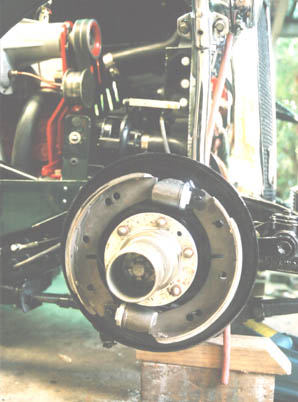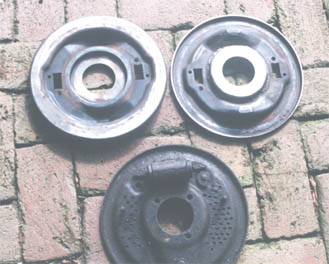


With the scope for variables and alternatives available in this type of conversion, and the competence or otherwise of those carrying out the work, I can accept no responsibility for the outcome. (Just for the benefit for those overly-zealous with thoughts of litigation if they make a mess of things!) There is no kit, drawings or measurements. What follows is merely a report on the discoveries and progress by an MG owner with only average skills and an insatiable appetite to tinker
HOW IT WORKS
Very briefly, one of the main aspects of TLS braking system is not simply the more even contact of the brake shoes with the brake drum, or the gaining of additional friction material on the shoes. It was explained to me the greatest advantage is the servo effect of the brake drum actually assisting the wheel cylinder pistons to exert pressure. Understanding the basic fundamentals is critical. The backing plates and cylinders are 'handed'. Get it wrong and you will have twin TRAILING shoes which will result in braking less effective than the standard MG set-up. The conversion alone will not compensate for deficiencies or wear in a number of other key points, all of which contribute to effective braking effort. The condition of the suspension, shock absorbers, type/ size /condition of tyres and brake lining compound all contribute to being able to stop a machine with design origins going back almost 70 years.
SHOPPING
You will need to find a donor car fitted with nine-inch front drum brakes - TLS - to obtain the necessary hardware. Easier than it sounds.
Once numerous in Australia and other 'Commonwealth' countries, the type
of vehicle being sought is fast vanishing. Local wrecking yards rarely
keep much 'interesting' old stuff these days, most of which have been
consigned to the crusher. The gear I'm using came off a chance-find 'Morris
Major Elite' from a local scrap dealer, total cost: $5! New Zealand seems
to be the last repository of the type of car of interest to us, and friends
who have visited that country recently report that numbers still exist
in the wrecker's yards. A suggestion would be to try the NZ Nationwide
Auto Parts-Finding Service on:
http://www.motorparts.co.nz/
What you need are:
4 x wheel cylinders.
4 x brake shoes & return springs.
4 x 'Micram' adjusters.
2 x backing plates. (Depending on what donor car you find and method of
conversion you intend to follow).
Also very handy is having on hand an expert welder/ machinist, and a brake
mechanic who doesn't mind weird requests for non-stock brake components
- or endless questions.
Before stripping the donor backing plates of all fittings, study carefully the position of the wheel cylinders. The backing plates should carry markings 'Left' and 'Right'. If not make sketches or photograph the assembly order ...PARTICULARLY the position of the wheel cylinder with the piston's direction of thrust in relation to the forward rotation of the road wheel. Remember the warning about getting it wrong and creating twin TRAILING shoes!
Two new flexible brake hoses will need to be custom-made, with standard TC 7/16" UNF thread on the 'chassis' end and the new wheel cylinder(s) thread on the other. The length of the hoses may have to be increased - this will be dictated by the position of the 'input' wheel cylinder
Two steel brake pipes will be required to connect the wheel cylinders - a job for the brake mechanic.
WHAT'S NEXT?
A big subject… so I'll simply 'think aloud' and describe our method of attack:
Our first thoughts were to modify the existing TC backing plates. Obviously the original hardware would need to be stripped and a new method of locating/ securing the twin wheel cylinders completed. This was rejected as it would irreversibly modify a good pair of original TC backing plates. (I'm not so much a heathen as some would think)
Studying the 'Major's' backing plate revealed a considerable difference in dish or off-set. A spare TC Steering Knuckle was bench mounted on a jig and measurements taken noting the variance between MG and Morris backing plates. This also revealed the Morris unit had a much more pronounced outer lip which engaged the Morris brake drum to form a road grime excluder. Totally different to a TC.
The outer lip was machined off the 'Major's backing plate and a large central hole was machined to accept the locating flange on the axle side of the TC's steering knuckle. A 'cup' - large enough to fit the TC's steering knuckle into - was machined from solid bar and carefully tacked into the 'new' backing plate, taking care to achieve the same off-set as per TC. Back on the jig, the knuckle was fitted with the backing plate, wheel cylinders and shoes, and a spare hub complete with bearings, oil seal/ spacer fitted, and torqued up. The brake drum was then fitted and spun to check clearances.
Obviously we then had a gap from the brake drum to the outer edge of the backing plate. This would be an advantage for cooling if the TC was solely used in competition. But for aesthetics and road use a means to exclude stones and stares was thought necessary.
From a spare Morris 10/4 rear axle backing plate, a substitute outer lip was carefully machined off and welded onto the Morris Major's backing plate (The 10/4 is the same diameter to the TC's backing plate and very similar in contour.)
The photographs will better show just how the central cup and the outer lip were welded in place. Also apparent, another advantage of using the Morris Major's backing plate will be noticed on the R/H top photograph - the retention of the pressed brake shoe locating platforms. Without these, like the TC's locating pins, the brake shoes would have no positive location relative to the rotating brake drum.
Brake hoses were custom made by a local brake specialist - as was the re-sleeving of the wheel cylinders, and re-lining of the Morris brake shoes and spare TC rears with the same lining compound. The remnants of the Morris hose and a spare TC front hose were provided to correctly identify the thread types. The new hoses were approx 50mm longer than standard TC to allow for the more acute angle of the hose when on full lock.
The photograph taken looking over the front R/H shock absorber shows the external pipe linking the two wheel cylinders, carefully bent to clear the brake scoops (fitted much earlier on the standard TC backing plates, and transferred to the new set-up). Again these pipes were manufactured by the brake mechanics.
Adjustment of the brakes is via the 'Micram' slotted-head adjusters as seen in the remaining photograph. Normally a ˝" dia. access hole would need to be drilled in the brake drum's face to facilitate this. In my case this is achieved through the large cooling holes in the drums 'face'.
On the road the difference is not spectacular. The pedal effort is certainly reduced and the braking effect certainly more reassuring. This is with 16" wheels shod with Avon Turbospeed 600 x 16" tyres. In competition, fitted with wide 15" wheels fitted with 65-profile sticky radials, the difference is much more dramatic and effective.
The weak-link now is the standard TC brake drums. This is another subject … the modifying cast-iron drums from a modern production car. Bob Gruneau's superb drums would be ideal … maybe Santa will be kind next year!